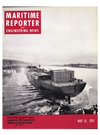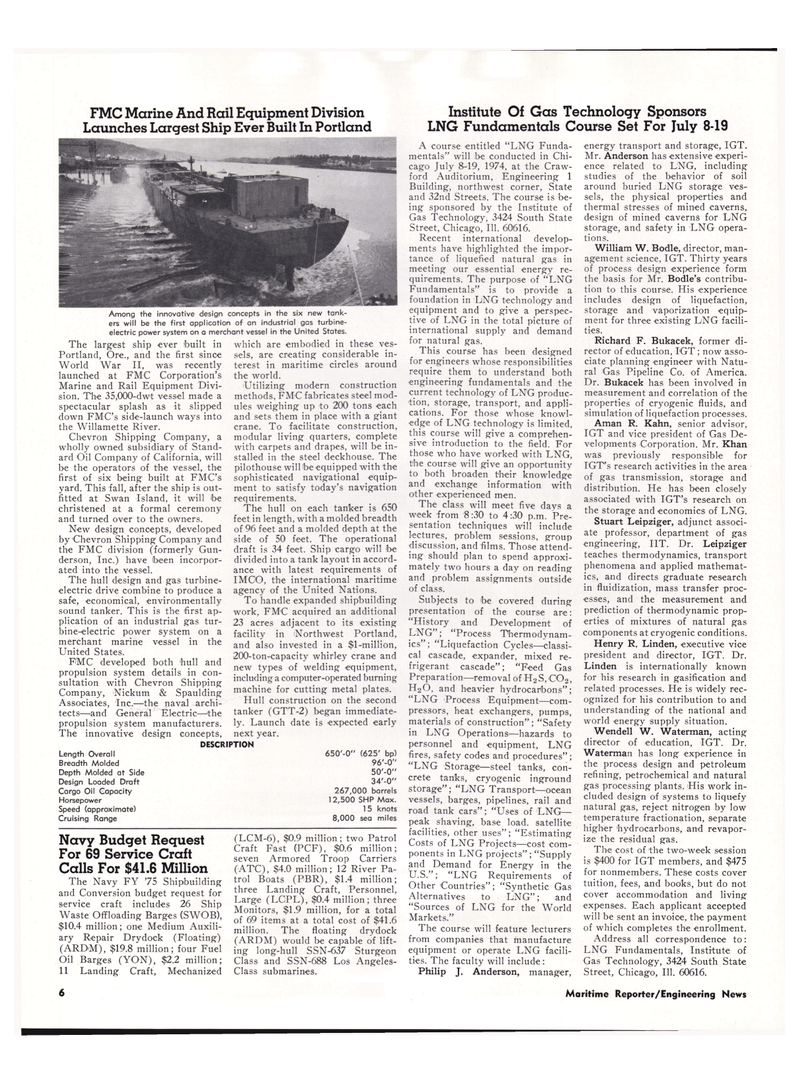
Page 4: of Maritime Reporter Magazine (May 15, 1974)
Read this page in Pdf, Flash or Html5 edition of May 15, 1974 Maritime Reporter Magazine
FMC Marine And Rail Equipment Division
Launches Largest Ship Ever Built In Portland
Institute Of Gas Technology Sponsors
LNG Fundamentals Course Set For July 8-19
Among the innovative design concepts in the six new tank- ers will be the first application of an industrial gas turbine- electric power system on a merchant vessel in the United States.
The largest ship ever 'built in
Portland, Ore., and the first since
World War II, was recently launched at FMC Corporation's
Marine and Rail Equipment Divi- sion. The 35,000-dwt vessel made a spectacular splash as it slipped down FMC's side-launch ways into the Willamette River.
Chevron Shipping- Company, a wholly owned subsidiary of Stand- ard Oil Company of California, will be the operators of the vessel, the first of six being built at FMC's yard. This fall, after the ship is out- fitted at Swan Island, it will be christened at a formal ceremony and turned over to the owners.
New design concepts, developed by Chevron Shipping Company and the FMC division (formerly Gun- derson, Inc.) have been incorpor- ated into the vessel.
The hull design and gas turbine- electric drive combine to produce a safe, economical, environmentally sound tanker. This is the first ap- plication of an industrial gas tur- bine-electric power system on a merchant marine vessel in the
United States.
FMC developed both hull and propulsion system details in con- sultation with Chevron Shipping
Company, Nickum & Spaulding
Associates, Inc.—the naval archi- tects—and General Electric—the propulsion system manufacturers.
The innovative design concepts,
DESCRIPTION
Length Overall
Breadth Molded
Depth Molded at Side
Design Loaded Draft
Cargo Oil Capacity
Horsepower
Speed (approximate)
Cruising Range which are embodied in these ves- sels, are creating considerable in- terest in maritime circles around the world.
Utilizing modern construction methods, FMC fabricates steel mod- ules weighing up to 200 tons each and sets them in place with a giant crane. To facilitate construction, modular living quarters, complete with carpets and drapes, will be in- stalled in the steel deckhouse. The pilothouse will be equipped with the sophisticated navigational equip- ment to satisfy today's navigation requirements.
The hull on each tanker is 650 feet in length, with a molded breadth of 96 feet and a molded depth at the side of 50 feet. The operational draft is 34 feet. Ship cargo will 'be divided into a tank layout in accord- ance with latest requirements of
IMCO, the international maritime agency of the United Nations.
To handle expanded shipbuilding work, FMC acquired an additional 23 acres adjacent to its existing facility in (Northwest Portland, and also invested in a $l-million, 200-ton-capacity whirley crane and new types of welding equipment, including a computer-operated burning machine for cutting metal plates.
Hull construction on the second tanker (GTT-2) began immediate- ly. Launch date is expected early next year. 650'-0" (625' bp) 96'-0" 50'-0" 34'-0" 267,000 barrels 12,500 SHP Max. 1 5 knots 8,000 sea miles
Navy Budget Request
For 69 Service Craft
Calls For $41.6 Million
The Navy FY 75 Shipbuilding and Conversion budget request for service craft includes 26 Ship
Waste Offloading Barges (SWOB), $10.4 million; one Medium Auxili- ary Repair Drydock (Floating) (ARDM), $19.8 million; four Fuel
Oil Barges (YON), $2.2 million; 11 Landing Craft, Mechanized (LCM-6), $0.9 million; two Patrol
Craft Fast (PCF), $0.6 million; seven Armored Troop Carriers (ATC), $4.0 million; 12 River Pa- trol Boats (PBR), $1.4 million; three Landing Craft, Personnel,
Large (LCPL), $0.4 million; three
Monitors, $1.9 million, for a total of 69 items at a total cost of $41.6 million. The floating drydock (ARDM) would be capable of lift- ing long-hull SSN-637 Sturgeon
Class and SSN-688 Los Angeles-
Class submarines.
A course entitled "LNG Funda- mentals" will be conducted in Chi- cago July 8-19, 1974, at the Craw- ford Auditorium, Engineering 1
Building, northwest corner, State and 32nd Streets. The course is be- ing sponsored by the Institute of
Gas Technology, 3424 South State
Street, Chicago, 111. 60616.
Recent international develop- ments have highlighted the impor- tance of liquefied natural gas in meeting our essential energy re- quirements. The purpose of "LNG
Fundamentals" is to provide a foundation in LNG technology and equipment and to give a perspec- tive of LNG in the total picture of international supply and demand for natural gas.
This course has been designed for engineers whose responsibilities require them to understand both engineering fundamentals and the current technology of LNG produc- tion, storage, transport, and appli- cations. For those whose knowl- edge of LNG technology is limited, this course will give a comprehen- sive introduction to the field. For those who have worked with LNG, the course will give an opportunity to both broaden their knowledge and exchange information with other experienced men.
The class will meet five days a week from 8:30 to 4:30 p.m. Pre- sentation techniques will include lectures, problem sessions, group discussion, and films. Those attend- ing should plan to spend approxi- mately two hours a day on reading and problem assignments outside of class.
Subjects to be covered during presentation of the course are: "History and Development of
LNG"; "Process Thermodynam- ics"; "Liquefaction Cycles—classi- cal cascade, expander, mixed re- frigerant cascade"; "Feed Gas
Preparation—removal of H2S,C02,
H20, and heavier hydrocarbons"; "LNG Process Equipment—com- pressors, heat exchangers, pumps, materials of construction"; "Safety in LNG Operations—hazards to personnel and equipment, LNG fires, safety codes and procedures"; "LNG Storage—steel tanks, con- crete tanks, cryogenic inground storage"; "LNG Transport—ocean vessels, barges, pipelines, rail and road tank cars"; "Uses of LNG— peak shaving, base load, satellite facilities, other uses"; "Estimating
Costs of LNG Projects—cost com- ponents in LNG projects" ; "Supply and Demand for Energy in the
U.S."; "LNG Requirements of
Other Countries"; "Synthetic Gas
Alternatives to LNG"; and "Sources of LNG for the World
Markets."
The course will feature lecturers from companies that manufacture equipment or operate LNG facili- ties. The faculty will include :
Philip J. Anderson, manager, energy transport and storage, IGT.
Mr. Anderson has extensive experi- ence related to LNG, including studies of the behavior of soil around buried LNG storage ves- sels, the physical properties and thermal stresses of mined caverns, design of mined caverns for LNG storage, and safety in LNG opera- tions.
William W. Bodle, director, man- agement science, IGT. Thirty years of process design experience form the basis for Mr. Bodle's contribu- tion to this course. His experience includes design of liquefaction, storage and vaporization equip- ment for three existing LNG facili- ties.
Richard F. Bukacek, former di- rector of education, IGT ; now asso- ciate planning engineer with Natu- ral Gas Pipeline Co. of America.
Dr. Bukacek has been involved in measurement and correlation of the properties of cryogenic fluids, and simulation of liquefaction processes.
Aman R. Kahn, senior advisor,
IGT and vice president of Gas De- velopments Corporation. Mr. Khan was previously responsible for
IGT's research activities in the area of gas transmission, storage and distribution. He has been closely associated with IGT's research on the storage and economics of LNG.
Stuart Leipziger, adjunct associ- ate professor, department of gas engineering, IIT. Dr. Leipziger teaches thermodynamics, transport phenomena and applied mathemat- ics, and directs graduate research in fluidization, mass transfer proc- esses, and the measurement and prediction of thermodynamic prop- erties of mixtures of natural gas components at cryogenic conditions.
Henry R. Linden, executive vice president and director, IGT. Dr.
Linden is internationally known for his research in gasification and related processes. He is widely rec- ognized for his contribution to and understanding of the national and world energy supply situation.
Wendell W. Waterman, acting director of education, IGT. Dr.
Waterman has long experience in the process design and petroleum refining, petrochemical and natural gas processing plants. His work in- cluded design of systems to liquefy natural gas, reject nitrogen by low temperature fractionation, separate higher hydrocarbons, and revapor- ize the residual gas.
The cost of the two-week session is $400 for IGT members, and $475 for nonmembers. These costs cover tuition, fees, and books, but do not cover accommodation and living expenses. Each applicant accepted will be sent an invoice, the payment of which completes the enrollment.
Address all correspondence to:
LNG Fundamentals, Institute of
Gas Technology, 3424 South State
Street, Chicago, 111. 60616. 6 Maritime Reporter/Engineering News

 3
3

 5
5
